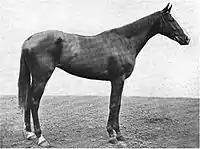| Blue Girl | |
|---|---|
 Blue Girl in 1901. | |
| Sire | Sir Dixon |
| Grandsire | Billet |
| Dam | Bonnie Blue |
| Damsire | Hindoo |
| Sex | Mare |
| Foaled | 1899 |
| Country | United States |
| Color | Chestnut |
| Breeder | Clay & Woodford partnership |
| Owner | 1) John E. Madden 2) William Collins Whitney 3) Harry Payne Whitney |
| Trainer | John E. Madden |
| Record | 12: 7-3-1 |
| Earnings | US$ 68,950 |
| Major wins | |
| Great American Stakes (1901) Juvenile Stakes (1901) Eclipse Stakes (1901) Great Trial Stakes (1901) Great Filly Stakes (1901) Ladies Handicap (1902) Gazelle Handicap (1902) | |
| Awards | |
| American Co-Champion Two-Year-Old Female (1901) American Champion Three-Year-Old Female (1902) | |
| Last updated on March 21, 2021 | |
Blue Girl (1899–1919) was an American Thoroughbred racemare that was the Champion 2 and 3-year old female in 1901 and 1902, respectively.
Pedigree
Blue Girl was bred in Kentucky by the Ezekiel Clay & Catesby Woodford breeding partnership and foaled at Clay's Runnymeade Stud.[1] She was sired by Sir Dixon, the 1888 Belmont Stakes winner, out of the mare Bonnie Blue.[2] Bonnie Blue was sired by the influential American sire Hindoo and also produced the semi-successful stallion Blues. Blue Girl was sold as a 2-year-old in 1901 to John E. Madden, the owner of the Lexington stud farm Hamburg Place.[1]
Racing career
Blue Girl was trained by John Madden as a two-year-old and won the Juvenile Stakes, Eclipse, Great Trial, and Great American Stakes for Madden, netting $38,230 in purse money. She was bought by William Collins Whitney in late 1901 and won the Great Filly Stakes winning $23,975. As a 3-year-old, Blue Girl won the Gazelle and Ladies Handicap. She started in the Flying Handicap, run at Sheepshead Bay, but she became lame during the race.[1] This was her last start, and overall Blue Girl started 12 times and won 7 races.[3]
Offspring
Blue Girl was retired in 1903 and was sent to Whitney's Brookdale Stud farm. She was sold to Frederick Johnson (as representative for Harry Payne Whitney) for $10,000 in October 1904 after William Whitney's death.[4] Blue Girl was sent to Britain in 1912, but returned to the United States in 1915[5] due to anti-American Thoroughbred sentiment and the passage of the Jersey Act. She produced thirteen foals, but none were as successful as Blue Girl. Her offspring include:[6]
- Tammany Hall, chestnut gelding by Meddler (1904)
- Blue Grass, chestnut filly by Hamburg (1906)
- Dalenburg, chestnut colt by Hamburg (1907) (exported to Britain)
- Bay filly by Hamburg (1908)
- Eton Blue, bay filly by Hamburg (1909)
- Brush By, colt by Broomstick (1910)
- Delft, bay filly by Burgomaster (1911, died 1926), granddam of 1926 2-year-old champion Scapa Flow
- Blume (GB), chestnut filly by Broomstick (1913)
- Bit of Blue (GB), chestnut filly by Lemberg (1914)
- Cobalt, bay gelding by Willonyx (1915)
- Blue Laddie, bay gelding by Cylgad (1916)
- Sky Blue, chestnut filly by All Gold (1918)[7]
- Chestnut colt by Pennant[8] (1919, died 1920)
Blue Girl died in 1919 at the Brookdale Stud.[7]
References
- 1 2 3 "Blue Laddie's dam great racer". Daily Racing Form. June 7, 1918. Retrieved 5 January 2011.
- ↑ "Blue Girl Pedigree". Retrieved 6 January 2011.
- ↑ "Blue Laddie's Dam Great Racer". Daily Racing Form at University of Kentucky Archives. 1918-06-07. Retrieved 2021-06-06.
- ↑ "Whitney horse sale draws crowd of 10,000" (PDF). The New York Times. October 11, 1904. Retrieved 14 March 2011.
- ↑ The American Stud Book. The Jockey Club. 1920.
- ↑ "Blue Girl Progeny". Retrieved 6 January 2011.
- 1 2 The American Stud Book, Volume XIII. The Jockey Club. 1924. p. 79.
- ↑ "Entries for 1921 Breeders' Futurity". Daily Racing Form. July 20, 1919. Retrieved 5 March 2011.